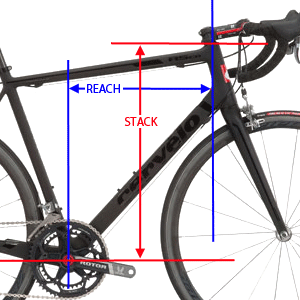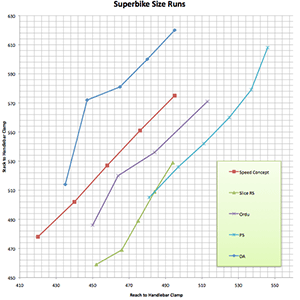The Stacktennial

It's been 10 years since the metrics Stack and Reach were first described. February marked a decade since these terms first made it into print, at least according to my recollection. Thanks to the Wayback Machine I’ve noted a citation in February of 2003.
Stack and Reach evolved well past my ambitions for these metrics. I never would have guessed they’d make their ways onto geometry charts for road and even MTB bikes. My only ambition was to find a way to compare tri bikes apples-to-apples. I needed a way to get from “points in space” or “fit coordinates” to complete bike solutions.
Stack and Reach popped into my head and it’s one of those intuitive moments anyone could have had, just, nobody did, because all the smart people were working on other stuff. But once Stack and Reach were out there, the varsity ran with that ball and Cervelo’s Damon Rinard and Trek’s Carl Matson are the engineers in this industry who’ve done more with it.
What these two engineers figured out pretty quickly is that Stack and Reach aren’t just outputs or passive descriptors. They aren’t simply ways to identify spots on a frame, for the purposes of a fit system. They can be—and are—used as dynamic inputs. You open up your CAD system and the very first thing you do in designing your new frame geometry is stick in Stack and Reach and engineer the bike back from these points. The P5, the S5, the Speed Concept, these bike models all were spawned with Stack as the daddy and Reach as the mommy.
I thought that in light of this 10th anniversary, we might spend a little time reflecting on where we’ve come, as an industry, through the use of Stack and Reach.
Actually, more than a little time. Over the next few weeks I’m going to re-examine Stack and Reach through the prism of road and tri bike fit, bike design, bike fit systems, and bike fit tools, with reviews of these systems and tools.
As Fit Metrics
Remember what Stack and Reach are. They are simply the X and Y—horizontal and vertical—distances between the bottom bracket and the head tube top. That’s it. No magic here.
You—and I mean you, as a bike rider—must attach to the bike at 3 points: the bottom bracket (that thing the crank attaches to); the saddle; and the handlebars. The handlebars attach to a stem and the stem attaches to the steer column, which is the top part of the fork that goes through the frame (specifically, the fork’s steer column—aka the “steerer”—passes through the frame’s head tube).
Most people agree that the best thing is to not have a lot of steerer sticking up above the frame, with spacers around it. This is neither strong, light, nor aerodynamic. Here’s the point, though. Focusing on the steerer locates our eyes on the head tube top—that place where the steerer exits the frame. You want your stem pretty close to that head tube top, not way far above it. This is what makes the head tube top notable and important. Hence our interest in this spot on the bike.
Look at it this way. Let’s talk about road bikes. Let’s say you’re 6 feet tall. Do you want to ride your road bike with a 140mm stem? Too long? How about a 60mm stem? Too short? Then, what length stem? 110mm you say? Plus or minus 10mm either way? Then you need a frame with a Reach that is thus-and-so—not longer, not shorter than that—or else your stem is not going to fit inside that 100mm-to-120mm window you’ve prescribed for it.
Likewise stack. Do you want your road bike to have a stem that points straight up to the moon? Do you want 40mm or 50mm of spacers under the stem? No? Then you’d better have a frame underneath you that terminates with a head tube top ready to accept a moderate headset top cap (5mm to 15mm tall), and then a minor number of spacers, so that the entire height of headset top cap plus spacers equals between 5mm and 25mm (I would call this 20mm window ideal).
You’ll want this same “window of acceptability” in the stem’s pitch. I think the window for that pitch is –6° to –17°. That stem pitch, on a typical road bike with a typical 73° head angle, means the stem extends forward parallel to the ground, or it’s angled up 11° from the horizon. Inside this 11° window sit stem pitches that look presentable.
”My” Stack and Reach
I still read on our and other reader forums things like—and this was just posted on our forum this week—“My Stack is [xxx] and Reach is [yyy].” Arrgh, facepalm, etc. I can see how religions take a left turn from the prophet’s original intent. Blessed are the cheesemakers! Let’s talk about what Stack and Reach are, and what they are not!
On a road bike, “my” Stack and Reach makes sense a little, because there are fewer variables. Still, let’s look at this. My current everyday rider, on the road, is a Cervelo R3 in size 58. This bike—this frame—has a Stack of 605mm and Reach of 396mm. Is this “my” Stack and Reach? It is if you assume a stem of 120mm, in a –17° pitch, with 15mm of headset top cap, no spacers otherwise, and a handlebar with a 70mm “bar reach" (this means my road handlebar has hooks that protrude, center-to-center, 70mm in front of the place where the bars pass through the stem). Only with this front end are the handlebar’s tops, hoods and drops placed where I want them. The minute you change the front end of that bike, this changes my position, and it requires some other change to accommodate or counteract the change made. For example, if I place a 130mm stem on my bike in place of its 120mm stem, then the bike is too long. A Reach of 396mm is no longer "my" Reach. Now 386mm is "my" Reach. Get it? Stack and Reach are wholly dependent on the front end configuration of the bike.
Lots of folks don’t like stems parallel to the ground. They like a slight rise. Let’s say I preferred a stem with a –6° rise. That stem, in 120mm, only differs in "run" from a –17° stem by 2mm (in other words the absolute horizontal length of a 120mm stem in a -6° config is 2mm less than in a -17° stem). So, the difference in the "run" of these stems is an inconsequential amount. However, that –6° stem will place the handlebars 23mm higher than will the –17° stem. I don’t want my handlebars 23mm higher. That's not inconsequential! In order to normalize for that height, the frame has to be 23mm lower to "make room" for this pitched-up stem—the frame's head tube top needs to be 23mm lower. In other words, the Stack of the bike needs to be 23mm lower. “My” Stack becomes 582mm instead of 605mm.
With this -6° stem on my bike, in place of a -17° stem, my Cervelo R3 won't fit me anymore. It's too tall. Rather, I'm all of a sudden pretty close to a Specialized Venge or Tarmac in size 58cm, or a Pinarello Dogma in 57.5, an Orbea Orca in size 57. I’m a BMC SLR01 in size 57. In fact, I’m dead spot on a Felt AR in size 58, which has a Stack and Reach of 589mm and 395mm respectively. But none of these bikes would fit me if I preferred a stem in a –17° config.

The image just above shows a front end featuring a 12mm headset top cap, a 10mm headset spacer, and a stem with a –6° pitch. As you see, that stem is still angled up from horizontal. My contention is that this is acceptable, even elegant, but is on the upturned end of elegant. That stem extension parallel to the ground is the downturned edge of elegant. That 22mm of total distance between the frame and the stem (the headset top cap + the 10mm spacer) is also near the edge of elegance. Yes, many people ride their bikes with many more spacers than that but, in my mind, this negates much of the value of the frame they thought they were buying.
The config in the image above places the center of the handlebar clamp 63mm above the head tube top, just in "rise". That's about as much as I would accept in a road bike, and really more than I want. I currently ride with 33mm of rise in my front end config and I'm very happy being in a range of about 30mm to 55mm.
The Aggravating factor that is the aerobar
Now, let’s take that and add a level of complexity. All of this would be exactly the same with tri bikes, if tri bikes didn’t have aerobars. All of this above describes the state of affairs up to the pursuit bar. Once you add an aerobar, you now have a new order of complexity, because pads do not sit a fixed distance above the pursuit bar. First of all, depending on the manufacturer, pads might sit 20mm, 30mm, 50mm, all the way up to 70mm above the centerline of the pursuit bar. Second, those pads can be pedestaled.
Imagine you have your tri bike perfectly positioned. But you lust after a new, more comfortable aerobar. So, you buy that aerobar and put it on your bike. Great! However, what if the pads on that aerobar sit 60mm above the pursuit bar, while the bar it’s replacing has pads that sit 30mm above the pursuit bar? If you buy a new, super comfortable 3T Aura, or one of Profile Design’s new 2013 aerobars with their ultra-comfy F35 armrests, and you sit these bars atop what were the OE Visiontech clip-ons that have been on your bike for 4 or 5 years, that’s exactly what you’ve done. Now your armrests sit 30mm higher than they did before. What are you going to do now?
This is why there is no such thing as “your” Stack and Reach. There is only the Stack and Reach that best suits you given: a particular stem length; stem pitch; headset top cap; number of spacers if any above that headset top cap; the aerobar of your choice; any pedestals under that aerobar. Only in those circumstances can you really talk about “your” Stack and Reach.
This is why Stack and Reach always must be described inside the confines of a particular front-end config, and it's why I never talk about Stack and Reach until I have first identified what that desired front-end config is, road or tri.
Finally, let’s make this even more confusing. You often can’t easily know what the front-end configuration of your perfect bike looks like, because today’s “superbikes”, that is, bikes with integrated frame, fork and stem, have their own proprietary metrics that are often unpublished. For example, if you determine that your best stem on a tri bike is 90mm long, -17° pitch, and so forth, what corresponds to that on the Aduro bar that comes on Cervelo’s P5 Six? Or Trek’s 9-Series Speed Concept? Or Cannondale’s Slice RS?
Light at the end of the tunnel
Seem confusing? Do not despair! I have not been hibernating lo these 10 years, nor have others in the world of tri bike fit. There are precise, granular solutions. Once you are properly positioned, the best among the bike fitters extent can tell you precisely what bikes, what models, with what front ends, match your perfect bike position. (I’ll describe how that happens in future installments.)
This does not mean that anyone who hangs a shingle, calling himself a fitter, can guide you through this. I know this will come as a shock to you, but there are F.I.S.T, Retul, Body Geometry, Trek, Serotta, and every other kind of certified, fitters out there who have no concept of what I’m writing about. “How can that be?” you might ask, since I may be the culprit who taught your local fitter? It’s the gap between what ought to be and what is. You can lead an IBD to fit education, but you can’t make him drink.
To that end, this series will also wax granular on fit certifications, and education—with an eye toward better education—a next step in professionalism, and greater comfort on the part of end users when they choose a fitter to patronize for fitting services.






Start the discussion at forum.slowtwitch.com